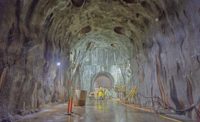...length of the pile or drilled shaft. The fully-cased shaft provides a “good concrete placement environment with the side walls of the drilled shaft always protected by casing,” says Rasband. Shafts lengths are typically not limited in unfavorable soil conditions with the oscillator method.
Soil conditions were not the only factors calling for mitigation – the oscillation method of drilling shafts helped UDOT Region 2 to be a good neighbor to residents, businesses and utilities in the area. Oscillator drilling causes minimal vibration, as opposed to pile driving and other drilled shaft methods. The Beck St. Bridge is located near pressurized utility lines and above ground rail road lines. Vibration from oscillation is far less likely to impact utilities and railroads. This advantage, allowed for safe, low risk progression of the construction process. Additionally, pile driving is loud and can be disruptive to businesses and residents.
Other advantages
The risk of slowing down or stopping a project due to underground obstructions is usually fully eliminated using a fully cased shaft. “We don’t typically have a hard time removing natural obstructions which can stop the progression of the drilling, “says Rasband who also reports that the State of Washington has tracked obstruction delay-cost dollars at zero due to use of the oscillator method in the past five years.
Malcolm’s approach can be better for populated areas. “Our job site is cleaner, says Rasband. The excavated soil is placed in the back of a truck and hauled away which is better in an urban environment.”
Work on the EXPRESSLink project happened quickly. Shafts typically take three to four days per shaft for the diameters and depths of shafts used at both bridge sites. The U.S. 89 portion took 12 shafts with three to four days per shafts just in drilling and pouring. Malcolm will return in the next phase of construction to build more drilled shafts at the Beck Street site.
What does this mean for UDOT?
Time saved means shorter project duration – the best way to limit impact to road users is to shorten the duration of construction. UDOT is continually looking for ways to reduce the price road users pay in inconvenience and delay. The oscillator drilled shafts approach, along with a design-build construction method and other construction techniques, work together to shorten the overall impact of construction on road users.
Elimination of risk keeps the project moving forward – A proven method that provides structural integrity quickly with less risk is, of course, always preferable.
Less direct impact to the closest neighbors – Less is more when it comes to noise and potential delay caused by vibrations that could possibly damage utilities or rail road lines.
Project facts
Prime contractor: Kiewit-Clyde Joint Venture
Sub-contractor: Malcolm Drilling Co., Inc.
Contracting method: Design-Build
Project location: Interstate 15; 500 North in Salt Lake City to the Interstate 215 connection in Davis County.

